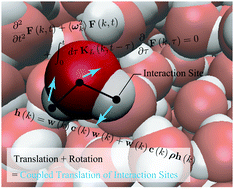Dynamics theory for molecular liquids based on an interaction site model
Abstract
Dynamics theories for molecular liquids based on an interaction site model have been developed over the past few decades and proved to be powerful tools to investigate various dynamical phenomena. In many of these theories, equations of time correlation functions are formulated by using the Zwanzig–Mori projection operator. Since algebriac equations are directly treated in these statistical mechanical approaches, the obtained dynamical properties are essentially free from statistical error. This perspective presents the theoretical framework of such theories and their applications, including visualization of diffusion processes, collective excitations, solvation dynamics, transport properties, and diffusion controlled reactions.

- This article is part of the themed collection: PCCP Perspectives


 Please wait while we load your content...
Please wait while we load your content...